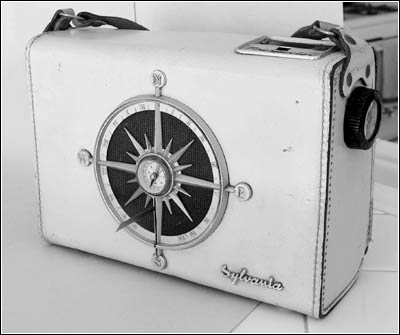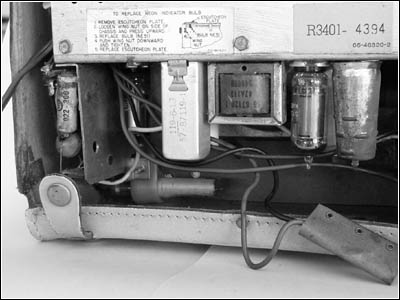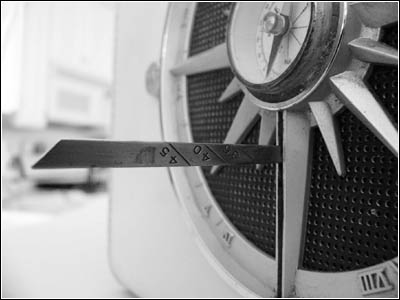Of Old Radios And Related Items--Published Monthly
The Sylvania 3401 "Prospector"
A Radio with Geiger Counter and Moreby Richard Arnold
Web Edition
Ever on the lookout for an unusual radio to buy and make the subject of an A.R.C. article, Richard Arnold's approach this time is slightly different. He doesn't own the radio, but he's met the owner's challenge to turn the information offered into an article. Another stroke of good luck for A.R.C. (Editor)
Here is a story of a very unusual radio that I'll bet not many of you have ever heard about -- a 1957 Sylvania 3401 portable AM radio that has a Geiger counter built into it.
One day, I was at the home of a collector/friend who knew that I liked to do research on radios and write about them for Antique Radio Classified. A friend of his had sent him some information on this set, and he offered it to me, saying, "Here, see what you can do with this."
Well, I guessed that was a challenge, and that is why I have decided to write this article. To begin, I contacted some collectors who own one of these rare radios on the Antique Radio Forum. They were willing to take the time to make their information available to me, and so I am able to put together this story.
Figure 1. The Sylvania "Prospector" Model 3401 is housed in a leather case. What appears to be a radio dial is actually a compass and sundial. This radio is unusual in that it includes a Geiger counter.The Sylvania Model 3401
The Sylvania Model 3401, called the "Prospector," is a 1957, AC-battery, portable, shown in Figure 1. The radio is an AM receiver with a Geiger counter, and it comes in a leather case with a shoulder strap. There are two model numbers given: One is a 3401TA in a tan leather case, and the other, a 3401BG. They both use the same chassis, given as number Ch. 1-612-1.
Along with using a selenium rectifier, the radio uses the following tubes: one each of a 1R5 as a converter, a 1U4 IF as an amplifier, and a 1U5 detector-AVC & AF amplifier. A 3V4 is used as a power output tube. Now, here is the kicker -- the radio also includes one Type VG18 Geiger-Muller tube.
Figure 2. An interior view of the Prospector's inverted chassis and Geiger-Muller tube shown horizontally at the bottom.Figure 2 shows an interior view of the radio. Note the inverted chassis and the Geiger-Muller tube at the left, just below the IF can.
The radio operates on 105-125 volts AC-DC or batteries and tunes in the broadcast band from 540 to 1650 Kc.
The Geiger counter part to this radio is pretty simple. There is a push button which, when pressed, activates a simple buzzer-transformer. The transformer generates a high voltage, which is stored in a capacitor. This high voltage is what operates the Geiger-Muller tube.
Each time a Uranium particle penetrates the Geiger-Muller tube it discharges (fires). Each time the Geiger tube fires, it passes a small pulse of current, which is coupled into the audio amplifier in the radio and makes a "click" in the speaker. The sudden pulse of plate current in the audio output tube causes a neon light to flash at the time that the click is heard. The push button and neon lamp are shown in Figure 3 (see print version).
Why a Geiger Counter?
Figure 5. A close-up of the sundial and its pulled-out vane. Note the use of Roman numerals on the sundial's face.When I first saw the pictures of this radio I thought back to the 1950s when I was a kid and we were all somewhat afraid of a nuclear attack from Russia. A lot of families back then built bomb shelters and had them stocked with all the necessities to maintain life should an attack have occurred. One of the most important items was a battery radio. I think that this Geiger counter radio could have been used not only to keep up with the news, but also to test the outside air to see if it was safe to venture out.
Well, of course, that was not really the radio's purpose. Back in the 1950s many people were out prospecting for uranium. There was a lot of money to be made up in them thar hills. I found out that this radio was used in prospecting for uranium. So, while someone was running up and down the mountains looking for uranium to make his fortune, he could also be enjoying his favorite AM radio program. Cool!
The radio also incorporates in its construction a built-in compass that is smack in the center of the front of the cabinet, as shown in Figure 4 (see print version). In addition, the radio includes a sundial, shown in Figure 5, with its pull-out vane.
So, this little radio seems to have it all -- an AC radio, a Geiger counter, a sundial, and a compass. For the weekend uranium hunter how could he lose?
I have been watching for one to show up on eBay, but so far none has. I have learned from others that they do appear from time to time and usually go for around $200 or so.
I want to thank Mr. Bill Jeffrey of Scottsdale, Arizona, a senior member of the Antique Radio Forum, for supplying me with the pictures shown in this article. Because of his contribution, we all now have a little more knowledge of what was an obscure little radio. Thanks too to Randy Bassham, also a member of the Antique Radio Forum, for the wonderful color brochure.
My friend Fielding Grigsby of Ardmore, Oklahoma, deserves full credit and thanks for initiating this whole project.
References:
Beitman, M.N. Most Often Needed Radio Service Information, Volume R-17, 1957.
Sams, Howard W. Set 345, Folder 17.
Photo credit: Bill Jeffrey
Brochure credit: Randy Bassham
(Richard Arnold, P.O. Box 275, Lone Grove, OK 73443)
Richard Arnold, a frequent contributor to A.R.C., has been collecting radios since 1985. His interest is primarily in cathedrals and 1920s battery sets, and his collection ranges from crystal sets to a 1928 American Bosch in a Pooley cabinet. His prize is the 1932 Jackson Bell Peter Pan featured in the June1991 A.R.C.
| [Free Sample] [Books, etc., For Sale] [Subscribe to A.R.C./Renew] [Classified Ads] [Auction Prices] [Event Calendar] [Links] [Home] [Issue Archives] [Book Reviews] [Subscription Information] [A.R.C. FAQ] URL = http://www.antiqueradio.com/May06_Arnold_Prospector.html Copyright © 1996-2006 by John V. Terrey - For personal use only. Last revised: April 24, 2006. For Customer Assistance please contact ARC@antiqueradio.com or call (866) 371-0512 toll free Pages designed/maintained by Wayward Fluffy Publications
Antique Radio Classified |


